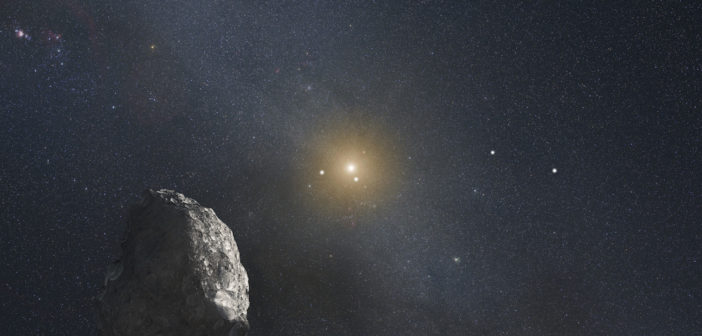What thoughts keep you awake at night? If it’s questions about how our solar system is going to end … wow, you really focus on the big picture! But some scientists have wondered the same thing, and they’ve got an answer for you: part of it will be swallowed, and the rest is probably going to disintegrate.
After the Sun Grows Old
Studying the likely fate of our solar system is “one of the oldest pursuits of astrophysics, tracing back to Newton himself,” according to the opening of a recent publication led by Jon Zink (UC Los Angeles). Though the tradition is long, this field is complicated: solving for the dynamical interactions between many bodies is a notoriously difficult problem.

As the Sun evolves, it will become a red giant star, growing in size until it has engulfed the inner planets. [Roen Kelly]
The outer planets will survive this evolution, but they won’t escape unscathed: since the gravitational pull of the Sun’s mass is what governs the planets’ orbits, our Sun’s weight loss will cause the outer planets to drift even farther out, weakening their tether to our solar system.
What happens next? Zink and collaborators play out the scenario using a series of N-body numerical simulations.
A Solar System No More
The authors’ simulations explore what happens to our outer planets after the Sun consumes the inner planets, loses half its mass, and begins its new life as a white dwarf. Zink and collaborators show how the giant planets will migrate outward in response to the Sun’s mass loss, forming a stable configuration in which Jupiter and Saturn settle into a 5:2 mean motion resonance — Jupiter will orbit five times for every two orbits of Saturn.

This plot shows when each outer planet is ejected from the solar system in the authors’ 10 simulations (represented by different colors). Click to enlarge. [Zink et al. 2020]
The last planet standing will stick around for a while longer. But within 100 billion years, even this final remaining planet will also be destabilized by stellar flybys and kicked out of the solar system. After their eviction, the giant planets will independently roam the galaxy, joining the population of free-floating planets without hosts.
Our fate, then, is bleak: the combination of solar mass loss and stellar flybys will lead to the complete dissolution of the solar system, according to these simulations. The good news? This fate is many billions of years in the future — so you needn’t lose sleep over it.
Citation
“The Great Inequality and the Dynamical Disintegration of the Outer Solar System,” Jon K. Zink et al 2020 AJ 160 232. doi:10.3847/1538-3881/abb8de

12 Comments
Pingback: Ostateczny los naszego Układu Słonecznego – PTMA Kraków
Pingback: Ostateczny los naszego Układu Słonecznego – Astronomia Śląska
Pingback: The Eventual Fate of Our Solar System - Sky & Telescope – THE USA EXPRESS
Pingback: The Eventual Fate of Our Solar System – Sky & Telescope | Space Force
Pingback: The Eventual Fate of Our Solar System – Sky & Telescope – Ten15AM
Pingback: The Eventual Fate of Our Solar System – Sky & Telescope - Fashion Blog
Pingback: From AAS NOVA: “The Eventual Fate of Our Solar System” | sciencesprings
Pingback: A completa desintegração do sistema solar pode ser mais rápida do que pensávamos - InfoBR
Pingback: O eventual destino do nosso Sistema Solar – Centro Ciência Viva do Algarve
Pingback: The Eventual Fate of Our Solar System - Sky & Telescope - News Corner
Pingback: 遠い未来、太陽系は接近する恒星によって解体されてしまうかもしれない | sorae 宇宙へのポータルサイト
Pingback: 遠い未来の太陽系は、アクセスする星によって解体されてしまうかもしれない| sorae宇宙のポータルサイト